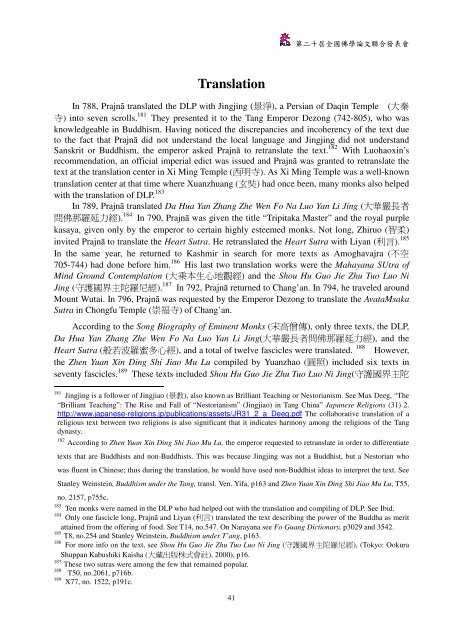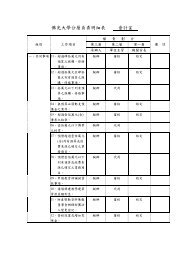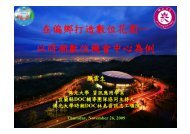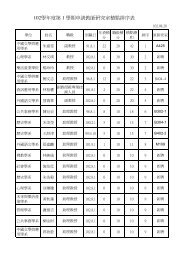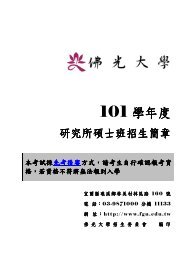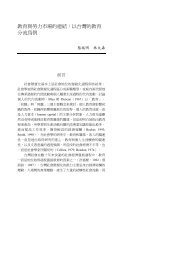【A 場】第一場論文集 - 佛光大學
【A 場】第一場論文集 - 佛光大學
【A 場】第一場論文集 - 佛光大學
- No tags were found...
Create successful ePaper yourself
Turn your PDF publications into a flip-book with our unique Google optimized e-Paper software.
第 二 十 屆 全峖 國 佛 學 論 文尠 聯 合峯 發 表 會TranslationIn 788, Prajnā translated the DLP with Jingjing ( 景 淨 ), a Persian of Daqin Temple ( 大 秦猵寺 ) into seven scrolls. 181 They presented it to the Tang Emperor Dezong (742-805), who wasknowledgeable in Buddhism. Having noticed the discrepancies and incoherency of the text dueto the fact that Prajnā did not understand the local language and Jingjing did not understandSanskrit or Buddhism, the emperor asked Prajnā to retranslate the text. 182 With Luohaoxin’srecommendation, an official imperial edict was issued and Prajnā was granted to retranslate thetext at the translation center in Xi Ming Temple ( 西 明 寺 ). As Xi Ming Temple was a well-knowntranslation center at that time where Xuanzhuang ( 玄 鞾 ) had once been, many monks also helpedwith the translation of DLP. 183In 789, Prajnā translated Da Hua Yan Zhang Zhe Wen Fo Na Luo Yan Li Jing ( 大 華 嚴詫 長 者問 佛 那倴 羅訌 延 力 經 ). 184 In 790, Prajnā was given the title “Tripitaka Master” and the royal purplekasaya, given only by the emperor to certain highly esteemed monks. Not long, Zhiruo ( 智 柔 )invited Prajnā to translate the Heart Sutra. He retranslated the Heart Sutra with Liyan ( 利 言借 ). 185In the same year, he returned to Kashmir in search for more texts as Amoghavajra ( 不 空705-744) had done before him. 186 His last two translation works were the Mahayana SUtra ofMind Ground Contemplation ( 大 乘靭 本 生 心 地 觀 經 ) and the Shou Hu Guo Jie Zhu Tuo Luo NiJing ( 守 護 國 界 主 陀 羅訌 尼 經 ). 187 In 792, Prajnā returned to Chang’an. In 794, he traveled aroundMount Wutai. In 796, Prajnā was requested by the Emperor Dezong to translate the AvataMsakaSutra in Chongfu Temple ( 崇 福 寺 ) of Chang’an.According to the Song Biography of Eminent Monks ( 宋侗 高珉 僧踶 傳 ), only three texts, the DLP,Da Hua Yan Zhang Zhe Wen Fo Na Luo Yan Li Jing( 大 華 嚴詫 長 者 問 佛 那倴 羅訌 延 力 經 ), and theHeart Sutra ( 般獭 若 波 羅訌 蜜犪 多 心 經 ), and a total of twelve fascicles were translated. 188 However,the Zhen Yuan Xin Ding Shi Jiao Mu Lu compiled by Yuanzhao ( 圓 照 ) included six texts inseventy fascicles. 189 These texts included Shou Hu Guo Jie Zhu Tuo Luo Ni Jing( 守 護 國 界 主 陀181 Jingjing is a follower of Jingjiao ( 景 教 ), also known as Brilliant Teaching or Nestorianism. See Max Deeg, “The“Brilliant Teaching”: The Rise and Fall of “Nestorianism” (Jingjiao) in Tang China” Japanese Religions (31) 2.http://www.japanese-religions.jp/publications/assets/JR31_2_a_Deeg.pdf The collaborative translation of areligious text between two religions is also significant that it indicates harmony among the religions of the Tangdynasty.182According to Zhen Yuan Xin Ding Shi Jiao Mu Lu, the emperor requested to retranslate in order to differentiatetexts that are Buddhists and non-Buddhists. This was because Jingjing was not a Buddhist, but a Nestorian whowas fluent in Chinese; thus during the translation, he would have used non-Buddhist ideas to interpret the text. SeeStanley Weinstein, Buddhism under the Tang, transl. Ven. Yifa, p163 and Zhen Yuan Xin Ding Shi Jiao Mu Lu, T55,no. 2157, p755c.183 Ten monks were named in the DLP who had helped out with the translation and compiling of DLP. See Ibid.184 Only one fascicle long, Prajnā and Liyan ( 利 言借 ) translated the text describing the power of the Buddha as meritattained from the offering of food. See T14, no.547. On Narayana see Fo Guang Dictionary, p3029 and 3542.185T8, no.254 and Stanley Weinstein, Buddhism under T’ang, p163.186 For more info on the text, see Shou Hu Guo Jie Zhu Tuo Luo Ni Jing ( 守 護 國 界 主 陀 羅訌 尼 經 ), (Tokyo: OokuraShuppan Kabushiki Kaisha ( 大 藏 出 版 株頶 式 會 社 ), 2000), p16.187These two sutras were among the few that remained popular.188T50, no.2061, p716b.189 X77, no. 1522, p191c.41


